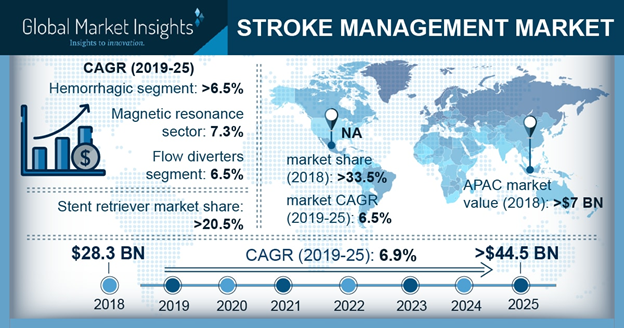Our Market
Competitor Analysis
The feasibility of continuous hemodynamic monitoring in acute stroke have remained largely unexplored due to the previous limitations of the technology [1]. There is currently no method in the market involving non-invasive, continuous blood pressure monitoring, making our solution unique. However, our device still holds advantages against other devices on the market as well as standard stroke assessment procedures. The standard assessment procedures such as Computed Tomography (CT) and Magnetic Resonance Imaging (MRI) possess drawbacks in the cost or lack of availability and accuracy [2]. Furthermore, standard methods can take hours to complete before a clinical stroke diagnosis can be made [2]. By then, it may be too late for treatments like intravenous tissue-plasminogen activator (iv-TPA) which is a protein solution delivered into the blood stream to break up blood clots. This treatment solution is only deemed effective up to 4.5 hours after the onset of severe symptoms of ischemic stroke [3]. An alternative, surgical solution is the mechanical thrombectomy where a neurosurgeon utilizes a stent-retriever inserted through the femoral artery in the leg to physically extract the clot [4].

Figure 1: Competitor Analysis in terms of cost, availability, and accuracy.
Figure 1 above shows the imaging modalities and the one commercially viable product known to us that our technology will be competing with. The CerebroTech visor utilizes impedance technology to calculate the volumetric flow of cerebral fluid as a means of monitoring flow distribution in the brain [5].
Market Plan
Our current end users include patients who are at high risk for stroke from poor health lifestyle, genetic predisposition or recurrence. The blood pressure sensors can be used to continuously monitor blood pressure to detect the onset of stroke in these high-risk patients, preventing delayed treatment. The business channels will include clinical settings and hospital networks, attracting customer segments by showing them clinical evidence for our device. Our market research shows that more than 795,000 people suffer from stroke and that 25% of these people are at a risk of recurrence [7]. As shown in Figure 2, the Stroke Management Market size was valued at $28.3 billion in 2018 and is forecast to reach $44.5 billion by 2025, growing at a compound annual growth rate (CAGR) of 6.9% [8]. Additionally, the ischemic stroke segment of the stroke management market held over 81% of the revenue share in 2018, further demonstrating the place in the market for our device [8] Driving factors including the globally increasing prevalence of chronic disease, the growing aging population, and the preference for minimally invasive procedures that are common among our end users [8]. With all these factors, we believe that our work is a part of a successful and growing industry.

Figure 2: U.S. Stroke Management Market Size [8].
References
[1] A. Sen, J. Miller, H. Wilkie, M. Moyer, C. Lewandowski, and R. Nowak, “Continuous Hemodynamic Monitoring in Acute Stroke: An Exploratory Analysis,”
Western Journal of Emergency Medicine, vol. 15, no. 4, pp. 345–350, Jul. 2014.
[2] P. Tadi, “Acute Stroke (Cerebrovascular Accident),” StatPearls [Internet]., 21-Feb-2020. [Online].
Available: https://www.ncbi.nlm.nih.gov/books/NBK535369/?fbclid=IwAR0LvTBNQ-bjZjfHNPz9kA4V1lucaE_0SPV3WSTL1FP-JqolSZJIyzFB-8M. [Accessed: 14-May-2020].
[3] N. T. Cheng and A. S. Kim, “Intravenous Thrombolysis for Acute Ischemic Stroke Within 3 Hours Versus Between 3 and 4.5 Hours of Symptom Onset,”
The Neurohospitalist, Jul-2015. [Online]. Available: https://www.ncbi.nlm.nih.gov/pmc/articles/PMC4530422/. [Accessed: 14-May-2020].
[4] “Mechanical Thrombectomy for Acute Ischemic Stroke | Stroke.” [Online]. Available: https://www.ahajournals.org/doi/full/10.1161/strokeaha.107.497115.
[Accessed: 14-May-2020].
[5] “Overview: Cerebrotech Visor for detecting stroke: Advice,” NICE. [Online]. Available: https://www.nice.org.uk/advice/mib165. [Accessed: 12-Mar-2020].
[6] New Guideline: MRI Better Than CT Scans at Diagnosing Stroke. [Online]. Available: https://www.aan.com/PressRoom/Home/PressRelease/849. [Accessed: 12-Mar-2020].
[7] “Stroke Facts,” Centers for Disease Control and Prevention, 31-Jan-2020. [Online]. Available: https://www.cdc.gov/stroke/facts.htm. [Accessed: 11-Mar-2020].
[8] “Stroke Management Market Statistics 2019-2025: Industry Forecasts,” Global Market Insights, Inc. [Online].
Available: https://www.gminsights.com/industry-analysis/stroke-management-market. [Accessed: 12-May-2020].
